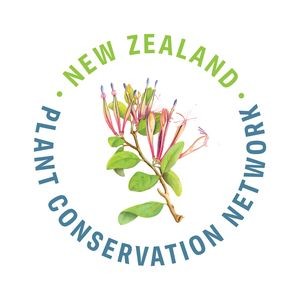Are we there yet? 10 years of the Plant Conservation Network
 In conjunction with Auckland Botanical Society, Landcare Research Manaaki Whenua, the Department of Conservation and Auckland and Massey Universities, the next NZPCN Conference will be held in Parnell at the Quality Hotel Parnell (parking is available at venue), Auckland from Thurs 23 – Sunday 26 May 2013. See draft conference programme, details of the pre-conference training day and flyer below and click on Register now to register for the conference:
In conjunction with Auckland Botanical Society, Landcare Research Manaaki Whenua, the Department of Conservation and Auckland and Massey Universities, the next NZPCN Conference will be held in Parnell at the Quality Hotel Parnell (parking is available at venue), Auckland from Thurs 23 – Sunday 26 May 2013. See draft conference programme, details of the pre-conference training day and flyer below and click on Register now to register for the conference:
- Call for papers (PDF, 642.28 kB) (now closed)
- Keynote speakers (PDF, 394.79 kB)
- Confirmed speakers
- Conference timetable
- Training day (PDF, 219.30 kB)
- Conference flyer (PDF, 244.91 kB)
- Cost of registration
Symposia
- Back from the brink – threatened plant recovery on islands, on private land, in sanctuaries and in the city. Recovery,monitoring and adaptive management of threatened plant populations by government, communities and landowners
- Keynote Speaker: Professor Dave Kelly (University of Canterbury) (PDF, 394.79 kB)
- Defining, understanding and banking our biota. Understanding our biota through systematics, biogeography and research on seed banks, plant diseases and autecology
- Keynote Speaker: Dr Peter Heenan (Landcare Research) (PDF, 394.79 kB)
- Keynote Speaker: Michael Way (Millennium Seed Bank)
- Naturalising natives – friend or foe? The biogeography and impact of native weeds such as karaka, pohutukawa,mangrove and pohuehue amongst others
- Keynote Speaker: Dr Leon Perrie (Te Papa Tongarewa) (PDF, 394.79 kB)
- Beyond the converted – plant conservation advocacy. Promotion of the indigenous flora—engaging with business, farmers, communities, gardeners and the public to use and protect native plants
- Keynote Speaker: Dame Anne Salmond (University of Auckland) (PDF, 394.79 kB)
- The urban native plant oasis – the importance of trees and urban habitats. The importance of parks, road corridors, natural fragments, trees and the urban forest and novel, human induced ecosystems in the urban matrix
- Keynote Speaker: Dr Mike Wilcox (Auckland) (PDF, 394.79 kB)
- What price conservation? Offsets, natural capital, nature’s services and the economic importance of native plants
Training Day
A pre-conference training day will be held at the Auckland Botanic Gardens on Thursday 23 May (sponsored by the gardens) and will allow participants to learn about plant identification, plant propagation and seed collection for the national seed bank. See the attachment for more details: Training Day (PDF, 219.30 kB) NOTE: The seed collection workshop is now full.
Welcome event
Delegates are invited to come to the Brew Bar on Quay Street from 5-30pm onwards on Thursday 23 May for some food and drinks to meet others prior to the conference starting.
Conference dinner
To be held on Sat 25 May 2013 at the Quality Hotel Parnell, Auckland from 7pm onwards. A charity auction will be held at this dinner to raise money for the David Given Research Fund and for threatened plant conservation initiatives.
Field trips (Sunday 26 May 2013)
Mataia Farm (Kaipara Harbour)
Start: 8am
Finish: 4pm
Mataia farm, set within the stunning Kaipara harbour, comprises1300ha of sheep and beef farm with 400ha of conservation land set aside. Working with the local community, conservation management aims to ensure a range of habitats are restored and the local wildlife is well protected. Our hosts Shane and Jenny will take you through a range of habitats including a small remnant kahikatea/totara forest, manuka shrub land, regenerating kauri, mature coastal broadleaf forest, saltmarsh flats and mature mangrove stands. This trip is designed for you to experience a range of vegetation types that characterise the Kaipara Ecological District so well and to highlight the incredible amount of conservation effort happening within the private sector.
Rotoroa Island
Start: 8-45am
Finish: 6-40pm
An 80 hectare island being revegetated by the Rotoroa Island Trust, which has established a public arts and conservation estate. The island has undergone a transformation with 20,000 pine trees felled and almost 400,000 plants sourced from local seed, propagated and planted on the island. A state-of-the-art exhibition centre and museum now showcase the island’s fascinating history and heritage buildings such as the jail, chapel and schoolhouse, have been restored.
Auckland’s Urban Forest
Start: 9am
Finish: 4pm
Visiting native bush reserves on Auckland’s North Shore, including Sacred Grove, Takapuna (ancient pohutukawa); Sylvan Park, Takapuna (kohekohe/puriri/karaka forest on edge of Lake Pupuke; Smiths Bush, Northcote (Kahikatea forest); Eskdale Reserve (mixed forest including swamp maire, and other reserves with fine examples of kauri-hard beech forest, taraire, kanuka and totara. Lunch will be provided at Kaipatiki Project Environment Centre, Birkdale, where we will also hear about this project and visit the native plant nursery.
